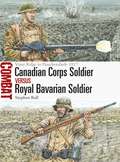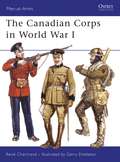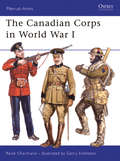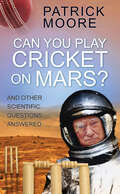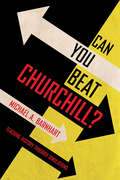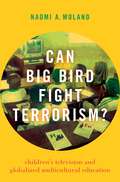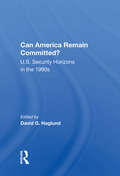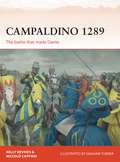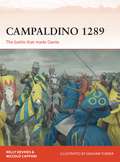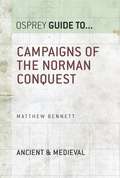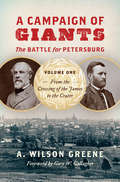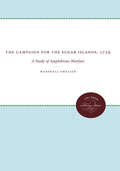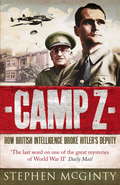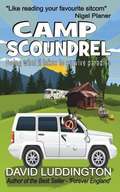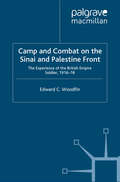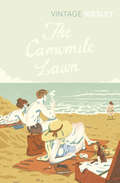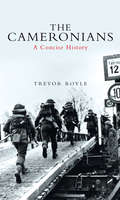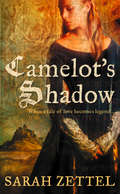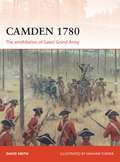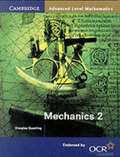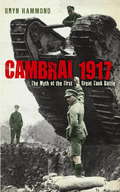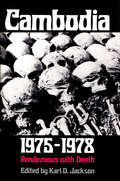- Table View
- List View
Canadian Corps Soldier vs Royal Bavarian Soldier: Vimy Ridge to Passchendaele 1917 (Combat)
by Adam Hook Stephen BullIn 1917 the soldiers of the Canadian Corps would prove themselves the equal of any fighting on the Western Front, while on the other side of the wire, the men of the Royal Bavarian Army won a distinguished reputation in combat. Employing the latest weapons and pioneering tactics, these two forces would clash in three notable encounters: the Canadian storming of Vimy Ridge, the back-and-forth engagement at Fresnoy and at the sodden, bloody battle of Passchendaele. Featuring carefully chosen archive photographs and specially commissioned artwork, this study assesses these three hard-fought battles in 1917 on the Western Front, and offers a new take on the evolving nature of infantry combat in World War I.
The Canadian Corps in World War I (Men-at-Arms)
by Gerry Embleton René ChartrandThis book describes the organization, lists the units and illustrates the uniforms and equipment of the four Canadian divisions which earned an elite reputation on the Western Front in 1915-18. Canada's 600,000 troops of whom more than 66,000 died and nearly 150,000 were wounded represented an extraordinary contribution to the British Empire's struggle. On grim battlefields from the Ypres Salient to the Somme, and from their stunning victory at Vimy Ridge to the final triumphant 'Hundred Days' advance of autumn 1918, Canada's soldiers proved themselves to be a remarkable army in their own right, founding a national tradition.
The Canadian Corps in World War I (Men-at-Arms)
by Gerry Embleton René ChartrandThis book describes the organization, lists the units and illustrates the uniforms and equipment of the four Canadian divisions which earned an elite reputation on the Western Front in 1915-18. Canada's 600,000 troops of whom more than 66,000 died and nearly 150,000 were wounded represented an extraordinary contribution to the British Empire's struggle. On grim battlefields from the Ypres Salient to the Somme, and from their stunning victory at Vimy Ridge to the final triumphant 'Hundred Days' advance of autumn 1918, Canada's soldiers proved themselves to be a remarkable army in their own right, founding a national tradition.
Can You Play Cricket on Mars?: And Other Scientific Questions Answered
by Sir Patrick MooreCan You Play Cricket on Mars? answers questions like: is there a dark side to the Moon? what happens when a comet hits the Sun? do the Martian canals have any water in them? is the Moon hot inside? what would happen if the Sun were to collide with a black hole? Mars has polar ice caps: could polar bears live there? if I could go back to the time of the dinosaurs, would the sky look the same as it does today? and many more.
Can You Beat Churchill?: Teaching History through Simulations
by Michael A. BarnhartHow do you get students to engage in a historical episode or era? How do you bring the immediacy and contingency of history to life? Michael A. Barnhart shares the secret to his award-winning success in the classroom with Can You Beat Churchill?, which encourages role-playing for immersive teaching and learning. Combating the declining enrollment in humanities classes, this innovative approach reminds us how critical learning skills are transmitted to students: by reactivating their curiosity and problem-solving abilities.Barnhart provides advice and procedures, both for the use of off-the-shelf commercial simulations and for the instructor who wishes to custom design a simulation from scratch. These reenactments allow students to step into the past, requiring them to think and act in ways historical figures might have. Students must make crucial or dramatic decisions, though these decisions need not align with the historical record. In doing so, they learn, through action and strategic consideration, the impact of real individuals and groups of people on the course of history. There is a quiet revolution underway in how history is taught to undergraduates. Can You Beat Churchill? hopes to make it a noisy one.
Can Big Bird Fight Terrorism?: Children's Television and Globalized Multicultural Education
by Naomi A. MolandSesame Street has taught generations of Americans their letters and numbers, and also how to better understand and get along with people of different races, faiths, ethnicities, and temperaments. But the show has a global reach as well, with more than thirty co-productions of Sesame Street that are viewed in over 150 countries. In recent years, the United States Agency for International Development (USAID) has provided funding to the New York-based Sesame Workshop to create international versions of Sesame Street. Many of these programs teach children to respect diversity and tolerate others, which some hope will ultimately help to build peace in conflict-affected societies. In fact, the U.S. government has funded local versions of the show in several countries enmeshed in conflict, including Afghanistan, Kosovo, Pakistan, Jordan, and Nigeria. Can Big Bird Fight Terrorism? takes an in-depth look at the Nigerian version, Sesame Square, which began airing in 2011. In addition to teaching preschool-level academic skills, Sesame Square seeks to promote peaceful coexistence-a daunting task in Nigeria, where escalating ethno-religious tensions and terrorism threaten to fracture the nation. After a year of interviewing Sesame creators, observing their production processes, conducting episode analysis, and talking to local educators who use the program in classrooms, Naomi Moland found that this child-focused use of soft power raised complex questions about how multicultural ideals translate into different settings. In Nigeria, where segregation, state fragility, and escalating conflict raise the stakes of peacebuilding efforts, multicultural education may be ineffective at best, and possibly even divisive. This book offers rare insights into the complexities, challenges, and dilemmas inherent in soft power attempts to teach the ideals of diversity and tolerance in countries suffering from internal conflicts.
Can Big Bird Fight Terrorism?: Children's Television and Globalized Multicultural Education
by Naomi A. MolandSesame Street has taught generations of Americans their letters and numbers, and also how to better understand and get along with people of different races, faiths, ethnicities, and temperaments. But the show has a global reach as well, with more than thirty co-productions of Sesame Street that are viewed in over 150 countries. In recent years, the United States Agency for International Development (USAID) has provided funding to the New York-based Sesame Workshop to create international versions of Sesame Street. Many of these programs teach children to respect diversity and tolerate others, which some hope will ultimately help to build peace in conflict-affected societies. In fact, the U.S. government has funded local versions of the show in several countries enmeshed in conflict, including Afghanistan, Kosovo, Pakistan, Jordan, and Nigeria. Can Big Bird Fight Terrorism? takes an in-depth look at the Nigerian version, Sesame Square, which began airing in 2011. In addition to teaching preschool-level academic skills, Sesame Square seeks to promote peaceful coexistence-a daunting task in Nigeria, where escalating ethno-religious tensions and terrorism threaten to fracture the nation. After a year of interviewing Sesame creators, observing their production processes, conducting episode analysis, and talking to local educators who use the program in classrooms, Naomi Moland found that this child-focused use of soft power raised complex questions about how multicultural ideals translate into different settings. In Nigeria, where segregation, state fragility, and escalating conflict raise the stakes of peacebuilding efforts, multicultural education may be ineffective at best, and possibly even divisive. This book offers rare insights into the complexities, challenges, and dilemmas inherent in soft power attempts to teach the ideals of diversity and tolerance in countries suffering from internal conflicts.
Can America Remain Committed?: U.s. Security Horizons In The 1990s
by David G. HaglundThe twelve months that spanned the period between the early springtimes of 1991 and 1992 may well turn out to constitute the most important year for American foreign and security policy in half a century. Encasing the dawning of a new and different security era, like macabre parentheses, were two columns of black smoke-that of 1991 over the newly liberated Kuwait, and that of 1992 over the embattled district of South-Central Los Angeles. Within these acrid temporal brackets unfolded a set of developments of utmost significance for American foreign and security policy and for the very meaning of the country's external commitments.
Can America Remain Committed?: U.s. Security Horizons In The 1990s
by David G. HaglundThe twelve months that spanned the period between the early springtimes of 1991 and 1992 may well turn out to constitute the most important year for American foreign and security policy in half a century. Encasing the dawning of a new and different security era, like macabre parentheses, were two columns of black smoke-that of 1991 over the newly liberated Kuwait, and that of 1992 over the embattled district of South-Central Los Angeles. Within these acrid temporal brackets unfolded a set of developments of utmost significance for American foreign and security policy and for the very meaning of the country's external commitments.
Campaldino 1289: The battle that made Dante (Campaign #324)
by Bounford.com Bounford.com Mr Graham Turner Paul Kime Kelly DeVries Niccolò CapponiCampaldino is one of the important battles between the Guelphs and Ghibellines - the major political factions in the city states of central and northern Italy. It heralded the rise of Florence to a dominant position over the area of Tuscany and was one of the last occassions when the Italian city militias contested a battle, with the 14th century seeing the rise of the condottiere in Italy's Wars.In this highly illustrated new study, renowned medieval historians Kelly De Vries and Niccolò Capponi have uncovered new material from the battlefield itself, as well as using all the available sources, to breathe new life into this colourful and fascinating battle.
Campaldino 1289: The battle that made Dante (Campaign)
by Graham Turner Bounford.com Bounford.com Paul Kime Kelly DeVries Niccolò CapponiCampaldino is one of the important battles between the Guelphs and Ghibellines - the major political factions in the city states of central and northern Italy. It heralded the rise of Florence to a dominant position over the area of Tuscany and was one of the last occassions when the Italian city militias contested a battle, with the 14th century seeing the rise of the condottiere in Italy's Wars.In this highly illustrated new study, renowned medieval historians Kelly De Vries and Niccolò Capponi have uncovered new material from the battlefield itself, as well as using all the available sources, to breathe new life into this colourful and fascinating battle.
Campaigns of the Norman Conquest (Guide to... #12)
by Matthew BennettThis book provides a full introduction to the Norman Conquest, an event which resulted in dramatic changes to the nation's aristocracy, church and administration. It brought a new language and cultural influences and revolutionised military architecture with the introduction of the castle. This profound impact was not brought about as the result of a single battle and it took a five-year war for William to establish control over his new kingdom. The campaigns are studied in detail, with maps showing how William's energy and strategic intelligence enabled him to defeat his formidable opponents and create a new order.
A Campaign of Giants--The Battle for Petersburg: Volume 1: From the Crossing of the James to the Crater (Civil War America)
by A. Wilson GreeneGrinding, bloody, and ultimately decisive, the Petersburg Campaign was the Civil War's longest and among its most complex. Ulysses S. Grant and Robert E. Lee squared off for more than nine months in their struggle for Petersburg, the key to the Confederate capital at Richmond. Featuring some of the war's most notorious battles, the campaign played out against a backdrop of political drama and crucial fighting elsewhere, with massive costs for soldiers and civilians alike. After failing to bull his way into Petersburg, Grant concentrated on isolating the city from its communications with the rest of the surviving Confederacy, stretching Lee's defenses to the breaking point. When Lee's desperate breakout attempt failed in March 1865, Grant launched his final offensives that forced the Confederates to abandon the city on April 2, 1865. A week later, Lee surrendered at Appomattox Court House.Here A. Wilson Greene opens his sweeping new three-volume history of the Petersburg Campaign, taking readers from Grant's crossing of the James in mid-June 1864 to the fateful Battle of the Crater on July 30. Full of fresh insights drawn from military, political, and social history, A Campaign of Giants is destined to be the definitive account of the campaign. With new perspectives on operational and tactical choices by commanders, the experiences of common soldiers and civilians, and the significant role of the United States Colored Troops in the fighting, this book offers essential reading for all those interested in the history of the Civil War.
The Campaign for the Sugar Islands, 1759: A Study of Amphibious Warfare (Published by the Omohundro Institute of Early American History and Culture and the University of North Carolina Press)
by Marshall SmelserIn the battle for empire that was the Seven Years' War, France's Sugar Islands, Guadeloupe and Martinique, were stakes as important as the Dominion of Canada. This book sketches the background strategy that led William Pitt to send an expedition to capture them, but it is chiefly the story of the campaign itself.Originally published in 1955.A UNC Press Enduring Edition -- UNC Press Enduring Editions use the latest in digital technology to make available again books from our distinguished backlist that were previously out of print. These editions are published unaltered from the original, and are presented in affordable paperback formats, bringing readers both historical and cultural value.
Camp Z: How British Intelligence Broke Hitler's Deputy
by Stephen McGintyOn 10 May 1941, Rudolf Hess, then the Deputy Führer, parachuted over Renfrewshire in Scotland on a mission to meet with the Duke of Hamilton, ostensibly to broker a peace deal with the British government. After being held in the Tower of London, he was transferred to Mytchett Place near Aldershot on 20 May, under the codename of 'Z'. The house was fitted with microphones and sound recording equipment, guarded by a battalion of soldiers and codenamed 'Camp Z'.Churchill's instructions were that Hess should be strictly isolated, with every effort taken to get any information out of him that could help change the course of the Second World War. Stephen McGinty uses documentation, contemporaneous reports, diaries, letters and memos to piece together a riveting account of the claustrophobia, paranoia and high-stakes gamesmanship being played out in an English country house. CAMP Z is a 'locked room mystery' where the 'locked room' is a man's mind that no one can conclude, with any degree of confidence, is sane.
Camp Scoundrel: Doing What It Takes To Survive Paradise (PDF)
by David LuddingtonWhen ex-SAS soldier, Michael Purdy, comes in front of the judge for hacking the bank account belonging to the Minister for Invalidity Benefits and wiping out his personal wealth, he braces himself for a prison sentence. What Michael doesn’t expect, is to be put in charge of a group of offenders and sent to a remote location in the Sierra Nevada Mountains in Spain to teach them survival skills as part of their rehabilitation programme. But Michael knows nothing at all about survival skills. He was sort of in the SAS, yes, but his shining record on the “Escape and Evasion” courses was more a testament to his computer skills than his ability to catch wildlife and barbecue it over an impromptu fire. Basically, he was the SAS’s techy nerd and only achieved that position as a result of a bet with a fellow hacker. Facing a stark choice between starvation or returning home to serve out their sentences, the group of offenders under Michael’s supervision soon realise that the only way to survive is to use their own unique set of skills – the kind of skills that got them arrested in the first place.
Camp and Combat on the Sinai and Palestine Front: The Experience of the British Empire Soldier, 1916-18
by E. WoodfinDunes, sandstorms, freezing crags and searing heat; these are not the usual images of World War I. For many men from all over the British Empire, this was the experience of the Great War. Based on soldiers' accounts, this book reveals the hardships and complexity of British Empire soldiers' lives in this oft-forgotten but important campaign.
The Camomile Lawn: A Novel (Black Swan Ser.)
by Mary WesleyOliver is just back from the Spanish Civil War and world-weary at only nineteen. Calypso is gorgeous, utterly selfish and determined to marry for money. Polly and Walter, brother and sister, play their cards close to their chests. Then there's little Sophie, who nobody loves. Soon the world will be swept into war again and the five cousins will enter a whirligig of sex, infidelity, love and loss, but for now they have one last, gaspingly hot summer at the house by the cliffs with the camomile lawn.A beloved bestseller from an author ahead of her time, The Camomile Lawn is a waspishly witty, devil-may-care delight.
The Cameronians: A Concise History
by Trevor RoyleIn May 1968, as part of cutbacks to the British Army, The Cameronians (Scottish Rifles) was disbanded at a moving ceremony held at the same spot in Douglas in Lanarkshire at which it had been raised in 1689. And yet, although the regiment is no more, its place in history is unassailable. The ceremony embraced the history of one regiment, The Cameronians, which had its origins in the turbulent period that accompanied the rise of the House of Orange at the end of the seventeenth century, while its other component part - the 90th (Perthshire Light Infantry) - was raised as a light infantry regiment during the war against Revolutionary France.Following amalgamation in 1881, The Cameronians (Scottish Rifles) quickly built up a solid reputation as a fighting regiment. During the First World War it raised 27 battalions and during the Second World War its battalions served in Europe and Burma. In the course of its long history, the regiment provided the British Army with many distinguished soldiers including three field marshals: Viscounts Hill and Wolseley and Sir Evelyn Wood.Always tough and enduring in battle, it reflected the character of its main recruitment area - Glasgow and Lanarkshire - and in later years it took self-conscious pride when the Germans nicknamed its soldiers Giftzwerge, or poison dwarfs. The Cameronians puts its story into the context of British military history and makes use of personal testimony to reveal the life of the regiment.
Camelot’s Shadow (The\paths To Camelot Ser. #Bk. 1)
by Sarah ZettelA stunning tale of romance and magic set against the legendary backdrop of King Arthur’s court.
Camden 1780: The annihilation of Gates’ Grand Army (Campaign #292)
by David Smith Graham TurnerAs the American Revolution continued, the British refocused their fight on the southern colonies in the hopes of triggering an outbreak of loyalism that would sweep the rebels aside. Under Sir Henry Clinton they captured Savannah at the end of 1778, and Charleston in May 1780, with Lord Cornwallis being left in command with just 8,500 men under him. Too thinly spread to guard the 15,000 square miles he was responsible for, Cornwallis went on the offensive, invading North Carolina and using Camden as a launch pad. This new history reveals how Cornwallis was able to use his aggressive strategy to great effect and how the overconfidence of the re-formed American forces under Horatio Gates was to result in a shocking defeat on the night of 15 August 1780 – a defeat that would allow Cornwallis to push deep into North Carolina the following year, where he would only be stopped by the American victory at Yorktown.
Camden 1780: The annihilation of Gates’ Grand Army (Campaign #292)
by Graham Turner David SmithAs the American Revolution continued, the British refocused their fight on the southern colonies in the hopes of triggering an outbreak of loyalism that would sweep the rebels aside. Under Sir Henry Clinton they captured Savannah at the end of 1778, and Charleston in May 1780, with Lord Cornwallis being left in command with just 8,500 men under him. Too thinly spread to guard the 15,000 square miles he was responsible for, Cornwallis went on the offensive, invading North Carolina and using Camden as a launch pad. This new history reveals how Cornwallis was able to use his aggressive strategy to great effect and how the overconfidence of the re-formed American forces under Horatio Gates was to result in a shocking defeat on the night of 15 August 1780 – a defeat that would allow Cornwallis to push deep into North Carolina the following year, where he would only be stopped by the American victory at Yorktown.
Cambridge Advanced Level Mathematics: Mechanics 2 for OCR (PDF)
by Douglas Arthur QuadlingThis book is part of a series of textbooks written specifically for the OCR modular mathematics syllabus. Mathematical ideas are explained carefully and clearly, with many stimulating worked examples. Mechanics 2 introduces projectiles, energy, circular motion and the study of rigid bodies. The final chapter is about strategies for problem-solving.
Cambrai 1917: The Myth Of The First Great Tank Battle
by Bryn HammondThe story of the first great tank battle, and the genesis of one of the most formidable weapons of the twentieth century. Cambrai was the last - and most influential - battle fought by the British on the Western Front in 1917. With many of the Allies on the brink of collapse, only Britain was still capable of holding the Germans at bay. Over time, many myths have grown up around what happened at Cambrai. The events of this iconic attack are now buried beneath accumulated legends and misrepresentations built up over almost a century. It is remembered as the world's first great tank battle, but it was the brilliant British innovations in artillery techniques that most shocked the enemy. Equally important were the new 'stormtroop' tactics the Germans pioneered. Drawing on previously unpublished letters, diaries, first-hand accounts and official reports, Bryn Hammond's definitive account examines this military milestone, how the myths were created, and how they changed the face of warfare for ever.
Cambodia, 1975-1978: Rendezvous with Death
by Karl D. JacksonOne of the most devastating periods in twentieth-century history was the rule of Pol Pot and the Khmer Rouge over Cambodia. From April 1975 to the beginning of the Vietnamese occupation in late December 1978, the country underwent perhaps the most violent and far-reaching of all modern revolutions. These six essays search for what can be explained in the ultimately inexplicable evils perpetrated by the Khmer Rouge. Accompanying them is a photo essay that provides shocking visual evidence of the tragedy of Cambodia's autogenocide. "The most important examination of the subject so far.... Without in any way denying the horror and brutality of the Khmers Rouges, the essays adopt a principle of detached analysis which makes their conclusion far more significant and convincing than the superficial images emanating from the television or cinema screen." --Ralph Smith, The Times Literary Supplement "A book that belongs on the shelf of every scholar interested in Cambodia, revolution, or communism.... Answers to questions such as `What effect did Khmer society have on the reign of the Khmer Rouge?' focus on understanding, rather than merely describing." --Randall Scott Clemons, Perspectives on Political Science
